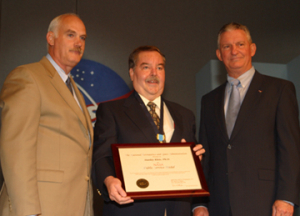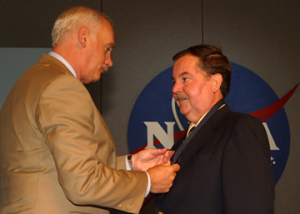Stanley Kleis, associate professor of mechanical engineering at the University of Houston Cullen College of Engineering, received one of NASA’s highest honors, the Public Service Medal, at the NASA Honor Awards Ceremony Tuesday at the Johnson Space Center. The award recognizes exceptional contributions to the mission of NASA by those who are not government employees.
Kleis, who holds a Ph.D. from Michigan State University, has worked with NASA for nearly 20 years to enhance the functionality of its bioreactors.
“I’ve been with NASA for about 16 years now in this cellular biotechnology program.” says NASA’s Steve Gonda, biotechnology scientist. “And when I came to NASA in 1988 as the program manager for the biotechnology program, I met Dr. Kleis. He has been supporting the biotechnology program going back as far as I can remember.”
Gonda, who nominated Kleis for the award, says that part of NASA’s focus is the development of space bioreactor systems that will support cell and tissue-based investigations in the space environment. These investigations will advance our understanding of the effects of this unique, low- gravity environment at the cellular and tissue levels, and ultimately contributes to reducing space-related risks to astronauts during long duration missions. NASA has a very comprehensive list of risks and questions associated with these risk areas. Many of these questions—about 40-50 percent of those questions—can be addressed by using cells and tissues, Gonda says.
“NASA has two decades of developing space bioreactors for operation on the Space Shuttle, Mir Station and the International space Station in support of investigators from university, federal and medical-research institutions. We have a good number of successes under our belt, one of which was to have the longest duration, longest continuous operating tissue engineering experiment in a bioreactor in space,” Gonda says. “Our bioreactor system operated continuously for 130 days, on the Mir station, the longest tissue engineering experiment of its kind. Dr. Kleis contributed for many years to the overall capability of our program to have a very successful experiment.”
After paving the way for the longest experiment, Kleis and his team, including master’s student Sandra Geffert, followed with more work that ultimately helped resolve a new and difficult problem.
During the long duration space experiment, the attending astronaut observed bubbles forming in the bioreactor vessel that could not be removed. “That was unacceptable,” says Gonda. “We have a very strong set of science requirements that our bioreactors are designed to and must meet. So this is where this award for Dr. Kleis really focuses. He was team-lead for experimental strategies, and he did computer-based analysis in his laboratory looking for oxygen distribution and shear stress of a new bioreactor system called the Hydrodynamic Focusing Bioreactor (HFB).”
Kleis and his team were able to take the HFB and conduct models in terms of shear stress and oxygen distribution, and from these models the team was able to develop ways to improve the design to optimize it to meet these science requirements. They then took it to the next stage: to test its bubble removal capability in a low-gravity environment on a series of KC-135 flights, and the tests were a complete success. NASA now has a space bioreactor vessel that will meet its science requirements and also remove any bubbles that form or are introduced into the vessel.
“It’s a major step forward for our program,” says Gonda. “During that time, Dr. Kleis’s teaching experience and his love of teaching came forward. We had a team here from JSC and also part of the team was from the Glenn Research Center, and Dr. Kleis was very adept at working with members of this team to fulfill our mission.”
Kleis expressed his heart-felt appreciation for the award, and then graciously extended thanks to many others who worked with him on the bioreactor systems.
“It is indeed an honor to receive the Public Service Medal for our work on the HFB project,” Kleis says. “Designing vessels for growing cells in micro gravity requires quite a different view of fluid dynamics. The basic principles are the same, but a whole new set of forces dominates the motions of cell aggregates and bubbles in space. At the same time an interdisciplinary approach is needed to deal with cell biology, fluid dynamics, mass transport, and mechanical design for micro gravity.
“We were very lucky to have a very talented team with members from NASA Johnson Space Center, NASA Glenn Research Center, WyleLife Sciences, Universities Space Research Associates, and the University of Houston. I would like to thank Dr. Neal Pellis and Dr. Steve Gonda for inviting me to participate in the HFB project and the entire Advanced Technology Development laboratory at NASA/JSC for their support.”

